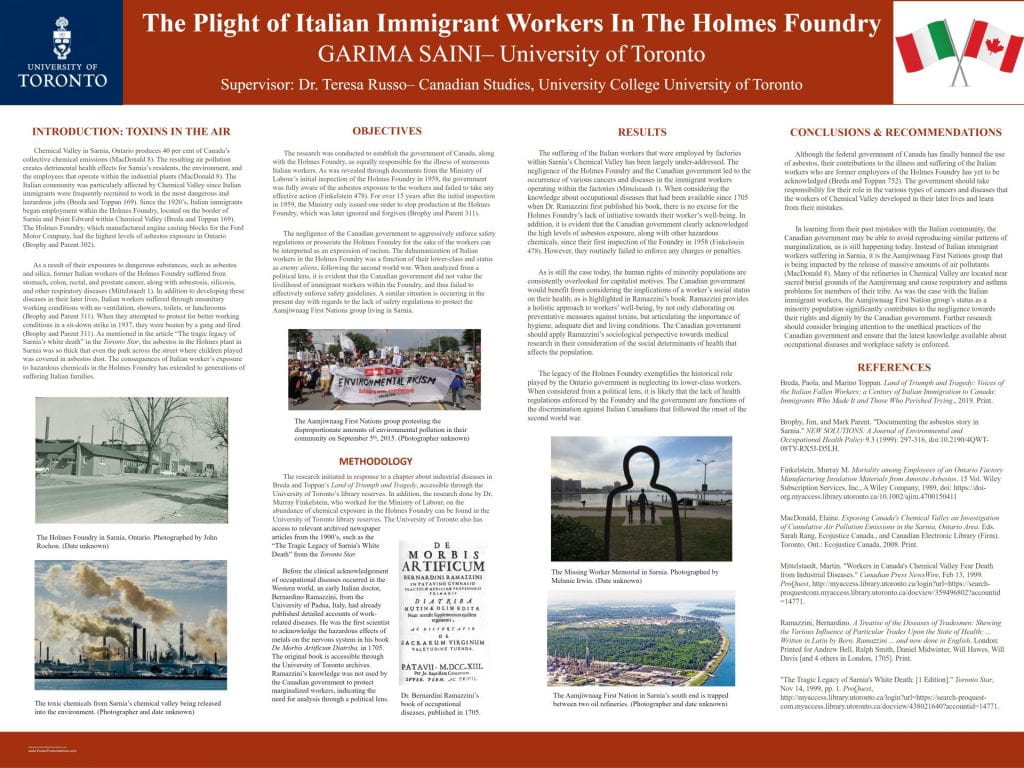
The Plight of Italian Immigrant Workers and the Aamjiwnaag First Nations Group in Sarnia
Chemical Valley in Sarnia, Ontario, contains over 60 chemical plants and oil refineries. The valley’s plants collectively produce 40 per cent of Canada’s chemical emissions (MacDonald 8). The resulting air pollution creates detrimental health effects for Sarnia’s residents, the environment, and the employees that operate within the industrial plants (MacDonald 8). The Italian community was particularly affected by Chemical Valley since many Italian immigrants were employed within one of its motor companies, the Holmes Foundry (Breda and Toppan 169).
The Holmes Foundry, which manufactured engine casting blocks for the Ford Motor Company, was largely negligent in monitoring their workers’ exposure to dangerous substances, such as asbestos and silica (Brophy and Parent 302). Consequently, many of their former workers, who were primarily immigrants, developed cancer, asbestosis, silicosis, and other respiratory diseases in their later lives (Mittelstaedt 1). In addition to developing these diseases, Italian workers, along with other immigrants, suffered through unsanitary working conditions with no ventilation, toilets, or showers (Brophy and Parent 311). Even worse, when they attempted to protest for better working conditions in a sit-down strike in 1937, they were beaten by a gang and fired (Brophy and Parent 311).
Before the clinical acknowledgement of occupational diseases occurred in the Western world, an early Italian doctor, Bernardino Ramazzini, from the University of Padua, Italy, had already published detailed accounts of work-related diseases. In his book De Morbis Artificum Diatriba, published in 1705, Ramazzini not only discussed the medical implications of toxins, but also considered the implications of a worker’s social status, lifestyle habits, and other social determinants of health. For example, in chapter VII, Ramazzini describes the effects of mercury exposure by stating that the workers “contemplate the reflection of their suffering in the very mirrors they have made… and curse the profession they have had to follow” (Riva et al. 2164). Ramazzini’s work is still relevant today, as government organizations continue to neglect the health of minority populations and fail to account for the social determinants of health.
As was revealed through the documents of the Ministry of Labour’s initial inspection of the Holmes Foundry in 1958, the government of Canada was well aware of the high levels of asbestos exposure to workers (Finkelstein 478). As recorded in the 1958 Ministry of Labour documents, Dr. Finkelstein expressed his concern for the “hazard of developing impaired lungs in that occupation” (Brophy and Parent 298). However, for over 15 years after the initial inspection in 1958, the government only issued one order to stop production in the Foundry, which was later ignored and forgiven (Brophy and Parent 311). Considering that the knowledge of occupational diseases was made available by Dr. Ramazzini in the 1700’s, and that the government of Canada produced its own evidence of toxic exposure in the Holmes Foundry, there is no excuse for why the hazards affecting former workers were overlooked.
The Holmes Foundry and the Canadian government are equally responsible for the dehumanization of Italian workers. When analyzed from a political lens, it is clear that the failure of the government to aggressively enforce safety regulations or prosecute the Holmes Foundry was a reflection of their racism towards Italian immigrants. Due to the low-class status of Italian workers at the time, resulting from the political implications of being an Italian Canadian during World War II, their lives were not valued by the Foundry, nor the Canadian government.
This form of systemic and environmental racism against minority populations is still apparent today, as can be seen in the case of the Aamjiwnaag First Nations group living in Sarnia. Many of the refineries in Chemical Valley are located near sacred burial grounds of the Aamjiwnaag and cause respiratory and asthma problems for members of their tribe (MacDonald 8). In addition, as has been revealed in a 2005 study by Environmental Health Perspectives, the chemicals released from the Valley are causing polychlorinated biphenyls in residents’ blood, mercury in their hair, and may be acting as endocrine-disrupting compounds that are changing individual’s hormonal make-up, affecting their ability to become pregnant (Dinshaw 2). As stated in an article by the National Observer, the use of banned chemicals has been termed “another form of genocide” against First Nations (Dinshaw 2). Despite protesting for their rights, just as the Italian immigrant workers did in 1937, their cries are ignored.
The Canadian government has not yet taken responsibility for its role in the various types of cancers and diseases that the workers of Chemical Valley developed in their later lives. It is clear that these patterns of marginalization are still causing harm to minority populations, like the Aamjiwnaag First Nations, today. In order to respect the rights and dignity of the Aamjiwnaag First Nations, the Canadian government should allocate resources to prevent chemical pollution of the sacred land and provide specialized health care for the damage that has already been done. In addition, the government should acknowledge the plight of the Italian workers in the Holmes Foundry and learn from their past mistakes. Further research should consider illuminating the unethical practices of the Canadian government and ensure that the latest knowledge available about occupational diseases, workplace safety, and environmental safety is enforced.
Garima Saini
University College at the University of Toronto, 2020
Works Cited
Breda, Paola, and Marino Toppan. Land of Triumph and Tragedy: Voices of the Italian Fallen
Workers: a Century of Italian Immigration to Canada: Immigrants Who Made It and Those Who Perished Trying. Verità, 2019. Print.
Brophy, Jim, and Mark Parent. “Documenting the asbestos story in Sarnia.” NEW SOLUTIONS: A Journal of Environmental and Occupational Health Policy 9.3 (1999): 297-316, doi:10.2190/4QWT-08TY-RX5J-D5LH.
Dinshaw, Fram. “First Nations Lead Protest against Pollution in Ontario’s Chemical Valley.” National Observer, 22 June 2016, www.nationalobserver.com/2015/09/07/news/first-nations-lead-protest-against-pollution-ontarios-chemical-valley.
Finkelstein, Murray M. Mortality among Employees of an Ontario Factory Manufacturing Insulation Materials from Amosite Asbestos. 15 Vol. Wiley Subscription Services, Inc., A Wiley Company, 1989. Web.
MacDonald, Elaine. Exposing Canada’s Chemical Valley an Investigation of Cumulative Air Pollution Emissions in the Sarnia, Ontario Area. eds. Sarah Rang, Ecojustice Canada., and Canadian Electronic Library (Firm). Toronto, Ont.: Ecojustice Canada, 2008. Print.
Mittelstaedt, Martin. “Workers in Canada’s Chemical Valley Fear Death from Industrial Diseases.” Canadian Press NewsWire, Feb 13, 1999. ProQuest, http://myaccess.library.utoronto.ca/login?url=https://search-proquest-com.myaccess.library.utoronto.ca/docview/359496802?accountid=14771.
Ramazzini, Bernardino. A Treatise of the Diseases of Tradesmen: Shewing the Various Influence of Particular Trades Upon the State of Health; … Written in Latin by Bern. Ramazzini … and now done in English. London: Printed for Andrew Bell, Ralph Smith, Daniel Midwinter, Will Hawes, Will Davis [and 4 others in London, 1705]. Print.
Riva, Michele Augusto, et al. “Bernardino Ramazzini (1633–1714).” Journal of neurology 265.9 (2018): 2164-5. Web.
How to cite this research
Saini, Garima. “The Plight of Italian Immigrant Workers and the Aamjiwnaag First Nations Group in Sarnia.” In Archival Research of Italian-Canadian Immigration and Culture, supvr. Teresa Russo, issue 2: Italian Fallen Workers, University of Guelph, April 2020, Guelph. Italian-Canadian Narratives Showcase Fallen Workers – Italian-Canadian Narratives Showcase (italianheritage.ca) (ICNS), Sandra Parmegiani and Nivashinee Ponambalum.


